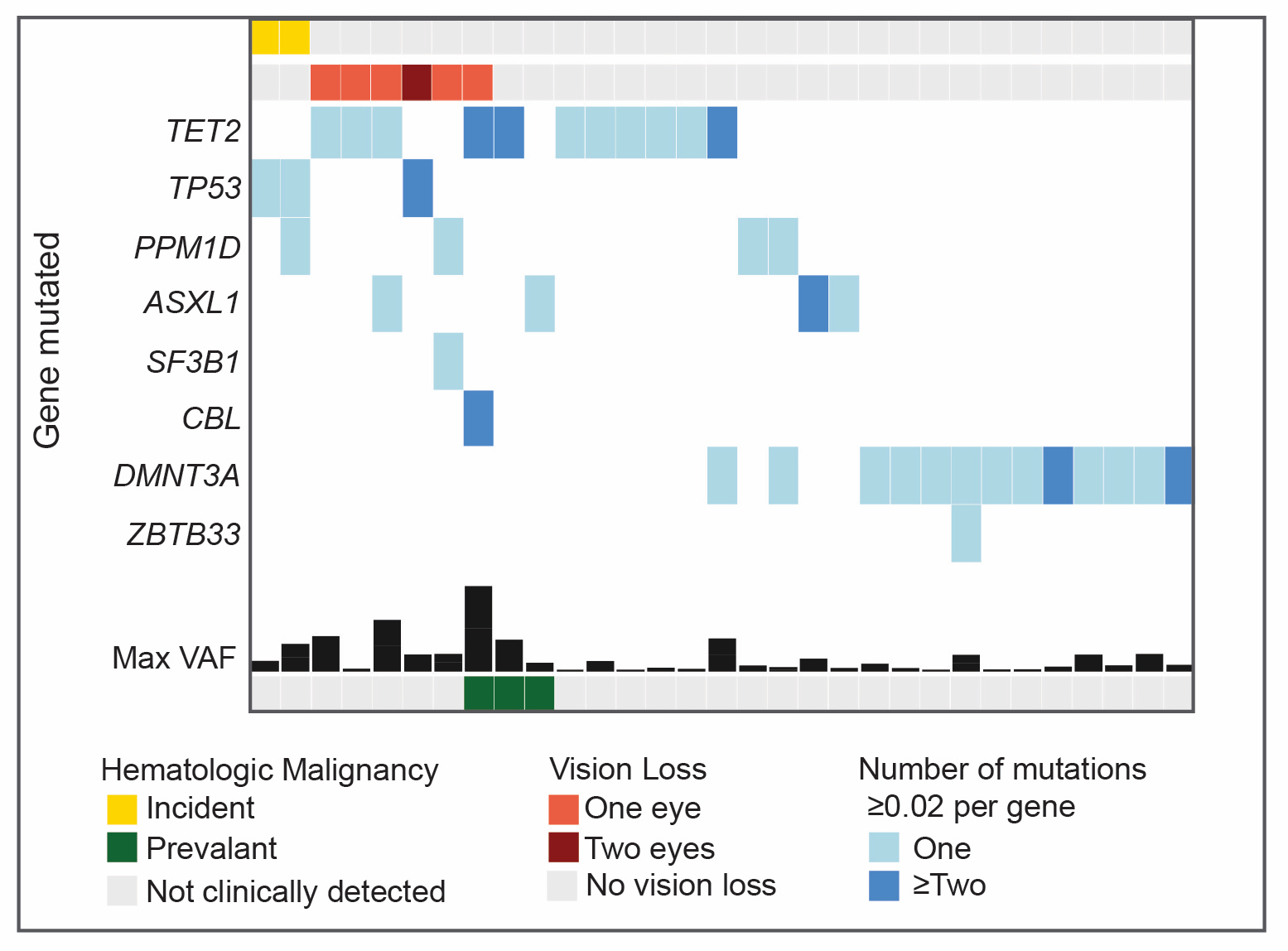Session Information
Date: Wednesday, November 15, 2023
Title: Abstracts: Vasculitis – Non-ANCA-Associated & Related Disorders III: Innovation
Session Type: Abstract Session
Session Time: 11:00AM-12:30PM
Background/Purpose: Giant cell arteritis (GCA) is an age-related vasculitis of large and medium vessels. Prior population studies have identified an association between GCA and hematologic malignancy (HM). Clonal hematopoiesis describes the age-related expansion of blood cells carrying somatic mutations that drive development of HM, most frequently in the epigenetic modifiers DNMT3A, TET2, and ASXL1. When the variant allele fraction (VAF) is ≥ 0.02, the terms clonal hematopoiesis of indeterminant potential (CHIP) and clonal cytopenia of uncertain significance (CCUS) are used to refer to patients without and with unexplained cytopenia, respectively. Individuals with CHIP/CCUS, especially mutated in TET2, develop many other age-related inflammatory-spectrum disorders including ischemic cardiovascular disease, non-alcoholic fatty liver disease, and gout. How the presence of CHIP, CCUS, or specific somatic mutation genotypes may influence the developmental and/or clinical outcomes in GCA is not well understood.
Methods: We analyzed sequenced exomes of 470960 UK Biobank participants for the presence of CH and used multivariable Cox regression to associate the presence of CHIP, CCUS, and the top three mutated genes with incident GCA. We then performed CH-panel targeted sequencing of DNA from blood samples from 114 patients with GCA recruited from a large academic health system who had a positive temporal artery biopsy, positive imaging, or met 1990 ACR classification criteria for clinical diagnosis GCA, of which 99% met 2022 ACR/EULAR classification criteria post-hoc. Abstraction of clinical data from the electronic medical record was performed to test association of TET2 with development of GCA-associated vision loss and to determine HM outcomes.
Results: We identified 779 UKB participants with incident GCA, of which 11.8% had CHIP/CCUS. CHIP/CCUS had a 1.48-fold increase in risk of incident GCA compared to UKB participants without CH. GCA risk was highest among individuals with CCUS (HR 2.98, p =0.0018) and with TET2-mutated CHIP/CCUS (HR 2.02, p =0.0012). Within the institutional GCA cohort, somatic mutations were detected in 27.2%, most commonly in DNMT3A (41.9%) and TET2 35.5%). TET2-mutated GCA was associated with vision loss (n = 4, OR 4.33, p = 0.047) (Figure 1). Overall, adverse outcomes (vision loss or incident HM) were associated with clones with larger VAF (median VAF 0.161 vs 0.049, p = 0.004). Cytopenia was common before and after GCA diagnosis, but few individuals underwent diagnostic evaluation for HM (7.2%) with abnormalities detected in most cases (87.5%). Compared to diagnosis of GCA, we observed prevalent HM in individuals with TET2 (n =2) and ASXL1 mutations (n=1) and incident HM only among individuals with TP53-mutant CH (n=2) (Figure 1).
Conclusion: CH increases risk for development of GCA in a genotype-specific fashion, with greatest risk being conferred by the presence of mutations in TET2. TET2 mutations likewise increase the risk of GCA-associated vision loss. Features associated in large population studies with increased risk of HM, namely CCUS and larger clone size, were also associated with increased development of GCA and adverse outcomes, respectively.
« Back to ACR Convergence 2023
ACR Meeting Abstracts - https://acrabstracts.org/abstract/clonal-hematopoiesis-is-associated-with-giant-cell-arteritis/

